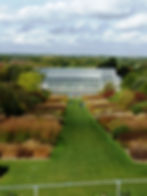Naturalistic Planting –promoting beauty and biodiversity!
This is the full article submitted to Professional Horticulture Magazine for Spring 2017
Parks and green space professionals are constantly searching for potential new approaches to managing public land in response to shrinking budgets and diminishing resources. Whilst it is hard to maintain enthusiasm for innovation when urgent cutbacks are the priority, the challenge of this generation of parks managers is to maintain quality whilst seriously cutting costs.

The movement to manage parks and green spaces more as nature reserves than gardens, has encouraged the development of longer grass and ‘wildflower meadow’ regimes in urban green spaces especially following the publication of the National Pollinator Strategy (2014) guidance. This management approach allows ecological and biodiversity quality to take precedence over either horticultural standards or the on-trend ‘cleansing’ approach to managing open spaces with its emphasis on tidiness.

Alongside, and in addition to, recent changes in mowing regimes, the past twenty years or so have seen the emergence of naturalistic, ecology-based, sustainable planting styles and maintenance regimes develop as an alternative approach to horticultural displays. These were developed early in Germany and the Netherlands and are now, at last, gaining some momentum in the UK, particularly following the stunning success of the Olympic Park planting for London 2012.

Variously termed Lebensbereich Planting, Steppe Planting, Prairie Planting, Sheffield School Planting, New Perennial Planting etc., they have replaced features such as seasonal bedding, herbaceous borders, shrub beds, and even lawns with more sustainable low-maintenance plantings, now often on a huge scale.
Although there were some forerunners and contemporaries in the UK with British plantspeople like William Robinson, Beth Chatto and Christopher Lloyd the style was fully developed in Germany (e.g. Hermannshof , Munich’s Westpark) and Holland (Amstelveen) spreading into Scandinavia. These naturalistic plantings give rich, often breathtakingly beautiful, displays throughout the year and over many years.

At their best, they evolve naturally, require no staking, chemicals or fertilisers and need minimum weeding with just an annual cut in late winter -all this whilst providing food, shelter and nesting sites for a wide range of wildlife.
The work of, amongst others, Piet Oudolf at the Chicago Millennium Park and at Wisley, and at Trentham with Tom Stuart-Smith or the picturesque meadows and naturalistic planting styles created by “Sheffield School” leading lights Nigel Dunnett and James Hitchmough, most notably in the 2012 Olympic Park, sets a benchmark for developers, planners and parks professionals in establishing highly attractive, reduced-maintenance, wildlife-friendly planting in an era of dwindling maintenance budgets.

The intelligent plantsmanship of Tom Stuart-Smith in the formal Charles Barry Italianate Garden at Trentham, or the Piet Oudolf tour-de-force on the Highline in New York shows how this style of planting can be adapted to any setting -traditional or contemporary. It therefore begs a number of questions –why have so few local authority green space professionals and planners taken up the style and methods?

Do local authorities have the resources and expertise to make the necessary changes? Is there training available, or can only a handful of eminent plantspeople with a vast knowledge of plants and a flair for beautiful styling make such planting successful?
Dr. Noel Kingsbury, a Sheffield alumnus, eminent garden designer and distinguished writer on plants, gardens and landscape, has played a vitally important role in popularising naturalistic and sustainable planting styles over the past twenty years. He has written a number of inspiring books on naturalistic planting including his collaborative work with the celebrated leading exponent of the style, Piet Oudolf. Their book Planting, A New Perspective has become the definitive handbook for green space managers on how to use grasses and forbs (non-grass herbs) to create sustainable ground-cover to stunning effect. It is the must-have manual for any of today’s aspiring plantspeople and landscape designers.

Dr Kingsbury also gives frequent popular lectures, workshops and talks (see his website http://www.noelkingsbury.com/ ) and last November at Ness Botanic Gardens on the Wirral, Cheshire, he led a fascinating workshop followed by his inspirational Leonard Broadbent Lecture* 2016, Wild about Perennials in which he examined the philosophy and practice behind naturalistic planting and related contemporary planting styles. It was standing room only in the large lecture theatre, a testament to the demand for guidance from the horticultural sector.
The morning workshop explored how the understanding of the ecology and botany of perennials and indigenous landscapes underpins successful design and management of schemes.

It was explained how and why some plants are short-lived or fail to compete in plant communities, whilst others prevail and dominate, and how understanding long-term perennial plant performance is vital to healthy and spectacular displays.

Plants have competitive strategies for success such as spreading in ‘phalanx’ or ‘guerrilla’ methods, or habits such as prolific self-seeding or cespitose forms of grasses where individual plants control their limited space, re-using limited resources, but seed prolifically to dominate an area.
It was clear that real knowledge and understanding of subjects such as the native conditions in which plants evolved, the differences between short-lived flowering species in less fertile meadows compared with long-flowered species from the more fertile prairies, and the extent to which modern cultivars could compete with strong species are all required in considering plant choice for successful plantings.
In Planting, A New Perspective (Timber Press) Dr Kingsbury gives clear insight into the design principles used by Piet Oudolf in his now-legendary designs.

He explains the terminology and concepts of primary, matrix and scatter plants, group planting, block planting, drifts and repetition, with the actual planting plans of many of Oudolf’s major schemes including the Highline in New York. There are sections on effectively combining plants, including the architecture of plants, colour groupings and seasonal display with a comprehensive directory of plants and their potential uses.
The naturalistic style has been successfully used in parks and open spaces throughout Europe and it is being increasingly adopted in the UK, but many local authorities, as part of savings programmes, are grassing over beds and borders without considering naturalistic planting as an option.

It is not the lowest cost option, but, especially in conjunction with grass/wildflower 'meadow’ regimes, these schemes reduce costs, whilst being attractive, sustainable and wildlife-friendly, and they retain plant interest in spaces that could otherwise become mown green grass deserts.
Wise green space professionals are familiarising themselves with this spectacularly effective and economic form of managing land and should seriously consider their potential when re-thinking displays in parks, town squares and gardens in future.
*The lecture honours Professor Leonard Broadbent, who died in 2002, was a plant scientist and Professor in Biology at the University of Bath. He was a powerful advocate for horticultural science and education. The RHS awarded him the Victoria Medal of Honour in 1980 for outstanding services to horticulture. The Lecture was created to highlight important and inspiring topics in Horticulture.

























